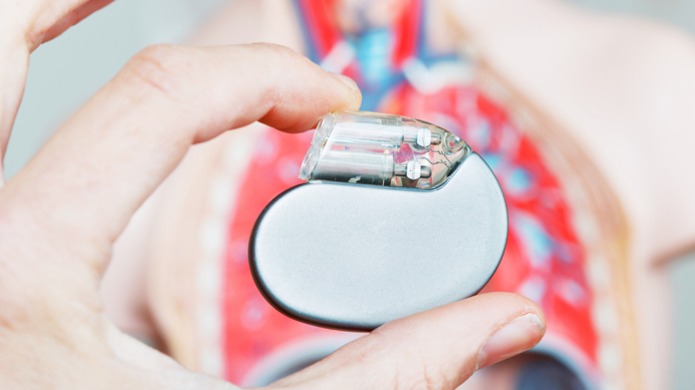What is a cardioverter defibrillator?
An implantable cardioverter defibrillator (ICD) is a device implanted to regulate irregular heart rhythms.
Like a pacemaker, an ICD consists of two parts. The leads are wires with electrodes at the tip that transmit electrical signals to and from the heart muscle.
The ICD is a small unit with a computer that monitors the heart rhythm and, when necessary, generates an electrical shock to restore a normal heart rate and rhythm.

The ICD can be programmed to meet your specific needs. It can also store important information about how the heart is performing that your doctor can periodically retrieve.
Why is it implanted?
An ICD is inserted to treat dangerous heart rate irregularities that occur in the lower chambers of the heart and to prevent cardiac arrest (cardiopulmonary arrest). An ICD looks much like a pacemaker but is designed to detect and treat slow heart rates (bradycardias) and fast heart rates (tachycardias). By delivering electrical shocks, the device treats these rhythm disorders and restores a normal heart rate and rhythm. ICDs also have pacing capabilities to keep the heart beating at a constant rate.
ICDs are usually prescribed for people who have experienced:
- At least one episode of ventricular tachycardia or ventricular fibrillation
- Previous cardiac arrest
- Situations where drug therapy (medication) was unable to control the heart rhythm problem, or caused severe or unacceptable side effects.
What is done?
There are several ways of implanting the leads of an ICD:
- Transvenous approach: Transvenous means through a vein. In this method, a small incision is made near your collarbone and the leads are maneuvered through a vein into the heart. The tip of each lead is positioned next to the inside wall of the heart (the endocardium).
- Thoracotomy: In this approach, your chest is opened and thin oval patches made of rubber and wire mesh are sewn onto the outside of the heart (epicardium). These patches are connected to the leads.
- Sternotomy: This approach is similar to a thoracotomy in that the chest is opened. The difference is that the incision is made over the breastbone (the sternum) and the leads are advanced into the heart. A sternotomy may be combined with coronary artery bypass surgery or heart valve surgery.
- Subxiphoid approach: This approach is also similar to a thoracotomy, but the incision is made slightly to the left of the breastbone (sternum).
Once the leads are in place and tested, they will be connected to the ICD unit. The ICD is then placed under the skin, either near the collarbone or somewhere above or at the waistline.
What can you expect?
Before the operation
Usually, the procedure is scheduled ahead of time. A week or so before your operation, you will probably be asked to visit your hospital for blood tests, urine tests, an electrocardiogram and other tests. Your doctor will explain the risks and benefits of the procedure and you will be asked to sign a consent form.
Before the procedure starts, inform your doctor if you:
- Have ever had a reaction to any contrast dye, iodine, or any serious allergic reaction (for example, from a bee sting or from eating shellfish)
- Have asthma
- Are allergic to any medication
- Have any bleeding problems or are taking blood-thinning medication
- Have a history of kidney problems or diabetes
- Have body piercings on your chest or abdomen
- Have had any recent change in your health
- Are, or may be, pregnant.
During the operation
- Usually, implantation is performed when you are awake but sedated with your chest area numbed with local anesthetics (similar to the anesthetics dentists use).
- Your surgeon will perform tests to find the best location for the leads and to ensure that the leads are connected correctly to the ICD.
- Once the ICD is implanted, additional testing may be performed to ensure the system will effectively correct your arrhythmia problem.
After the operation
After the procedure, you will be taken to a recovery room.
- You will probably feel drowsy and may feel some soreness around the site where the ICD was implanted.
- You can take pain medication to manage your discomfort.
- Depending upon your condition and which procedure you had, you may stay in the hospital for a few days.
- Before you leave, the ICD system may be tested again.
At home
When you return home, keep an eye on your incisions.
- Some bruising is normal but contact your doctor if you experience increased pain, redness, swelling, bleeding or other draining from an incision, fever, or chills.
- For the first few weeks, avoid sudden, jerky movements with your arms or stretching or reaching over your head.
Living with your ICD
When an ICD delivers its electrical impulse, some patients report feeling a fluttering in their chest with no discomfort or pain. Others say that they feel a “thump” in their chest which usually only lasts a few seconds.
Even with your ICD, you will still be given medication to reduce the number of heart rate irregularities. This medication should reduce the need for the ICD to generate unnecessary impulses. If you get many strong shocks within a short period, you should see your doctor or go to the emergency room without delay.
Precautions
Always carry your ICD ID card and inform your doctor, nurse or technician that you have an ICD. Medical procedures such as magnetic resonance imaging (MRI) can disrupt your ICD. So can devices that are electrical or have a magnetic field. Avoid prolonged or close contact with cell phones and MP3 players (for example, iPods), microwave ovens, metal detectors, industrial welders and electrical generators. Cell phones and iPods should not be kept in front pockets or held against the ear on the same side as the ICD.
Driving
Whether you are allowed to drive will depend on the extent of your condition and provincial laws. If you have a history of cardiac arrest, ventricular arrhythmia or fainting you will be asked to stop driving until you remain symptom free for up to six months.
Taking care of your ICD
The ICD should be checked several times a year at the doctor’s office. The batteries can last up to seven years and will be replaced by the doctor before they run out.
Deactivating your ICD
Some people may consider turning off the shock function of their ICD when they are no longer happy with their quality of life. For some, this may be due to worsening heart problems; for others, it may be from a new problem such as cancer or a severe stroke.
It is important that you talk about ICD deactivation with your family and health care team members so that everyone understands what is involved and you can make your personal wishes clear.
Related information
You and your ICD (Hamilton Health Sciences)
Implantable cardioverter defibrillator guide (Ottawa Heart Institute)
